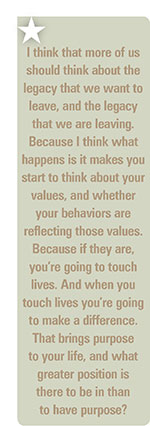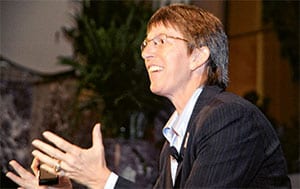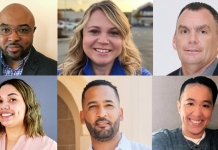Establishing a professional growth plan is as much an exercise in self-reflection as it is a process of setting and reaching professional goals. Rebecca “Becky” Halstead is a retired U.S. Army Brigadier General. She is the first general officer from her graduating class, the first female graduate of West Point to become a general officer, and the first woman in the history of the U.S. military to serve as a commanding general in combat. Halstead founded STEADFAST Leadership, a consultancy focusing on leadership training and motivational speaking. She is the author of 24/7: The First Person You Must Lead Is You. Halstead was the featured speaker at LP Magazine’s annual editorial board meeting in Savannah, Georgia. Her message is as insightful and important today as it was then.
EDITOR: When you first hear about General Becky Halstead and all the firsts that she has accomplished, I think the initial reaction is that hers is a story about women getting ahead in the military and business: a gender diversity story. That’s partly true, but reading your book, diversity has a different meaning for you. What is that?
 HALSTEAD: I had a really great boss once who told me, “Becky, someday you’ll be a general, and I’m going to give you one piece of advice. Don’t surround yourself with little Becky Halsteads.” At first I thought, now what did he mean by that? His point was that if I surround myself with people who think like me, who look like me, who have the same experience as I do, then I won’t have the strongest team. On a strong team, the best solutions come from diverse inputs, and that comes from people who have diverse experience.
HALSTEAD: I had a really great boss once who told me, “Becky, someday you’ll be a general, and I’m going to give you one piece of advice. Don’t surround yourself with little Becky Halsteads.” At first I thought, now what did he mean by that? His point was that if I surround myself with people who think like me, who look like me, who have the same experience as I do, then I won’t have the strongest team. On a strong team, the best solutions come from diverse inputs, and that comes from people who have diverse experience.
I always say that character has no gender. A leader is a person of character and competence. That’s fusion of heart and mind. That’s what’s on the inside. It has nothing to do with what you see on the outside. If that’s the premise, then when you talk about diversity, you can use metrics like male-to-female ratios, different religious preferences, ethnicity, but those are more along the lines of equal-opportunity-type metrics. To me, diversity is having a group of people who truly think differently.
When it came to my having to make decisions, I usually got about twelve different opinions. My charge as the leader is to listen to those opinions and then use some discernment to figure out what my decision will be. And it’s not an easy position to be in because you’re never going to please everybody. But you have to do what you think is absolutely right.
EDITOR: After your retirement from the U.S. Army, you decided to become an author, consultant, and speaker on leadership. Why follow that professional growth plan when your background in logistics could have paved the way for an executive position in corporate America?
HALSTEAD: My dad asked the same thing. When continuing to follow my own professional growth plan, why would I not seek a C-suite position when I had all the experience in supply-chain management and leadership at such a high level? It’s because I enjoy sharing my experience with other people, not in a boastful way, but in a way that could help others develop themselves as leaders. I think that we underestimate the power of sharing our stories. I’ve had people come up to me after I speak and say, “What I heard today was exactly what I needed, like the kick in the butt or the pat on the back, to get me going and get me off a dime.” If I can share with other people the lessons I’ve learned from almost three decades of military leadership, both the blemishes and the successes, and if those lessons help another individual find a better version of themselves, establishing and following their own professional growth plan. That for me is very, very rewarding. I love to help people find a better version of themselves. I felt like I could do that in this capacity much better than being confined to just one organization.
 EDITOR: Switching gears back to your formative years, what was it like growing up? Were there any early childhood experiences that led to your decision to apply to West Point?
EDITOR: Switching gears back to your formative years, what was it like growing up? Were there any early childhood experiences that led to your decision to apply to West Point?
HALSTEAD: I always say that I’m just a country girl from a town with no traffic light. The town is called Willseyville, in Upstate New York, and there’s still no traffic light today. My dad worked for IBM, International Business Machines, although we referred to it as I’ve Been Moved because in the first eight to ten years of my life we moved four or five times.
I have two sisters and one brother, and we were very disciplined. It was very important that we had responsibilities and were held accountable between church, community, school, and sports. I had a great love of sports. I was the athlete in the family, even at five foot one, but it’s very easy to be an athlete in a town with no traffic lights because the competition is pretty narrow. But I learned that I loved being on a team and leading the team. So I decided in high school that I would go to Ithaca College and be a coach and teach physical education.
But in my junior year in 1976 my mother was reading in the newspaper that the president had approved a measure allowing women to go to the country’s military academies. She told me, “I think this sounds just like you.” I said, “Mom, I have no idea what you’re talking about.” She says, “No, listen to this. I think going to one of these academies sounds just like you.” I call my mom the renaissance mom because there’s no way in 1976 that most mothers were looking for their daughters to go to military schools, and so I said, “Okay, if you help me with the application,” which was a very lengthy process of writing your congressmen and your senators and getting letters of recommendation, “if you help me with that process, I’ll try.”
Honestly, I had no concerns about being accepted; I knew I wouldn’t be. I had read about these schools. The kids that go are number one or two in their class and gifted athletes. The competition is incredibly fierce. I figured I was just doing it to please my mother. It was with great surprise that in the spring of my senior year, I actually received an acceptance letter from the United States Military Academy at West Point. It was probably the first time in my life that I remember being genuinely, completely surprised. Then I quickly went to being very scared and anxious, but what are you going to do? I couldn’t turn it down at that point. So, off I went to West Point, quite scared, quite uncertain. And after getting there I wanted to quit every single day. It was a very tough environment, but one that really helped me and shaped me into the leader that I am today.
 EDITOR: How does that experience at West Pointthe yelling, the tough love, the hazing, the strong disciplinehow does that relate to how you’re talking about leadership to corporate America?
EDITOR: How does that experience at West Pointthe yelling, the tough love, the hazing, the strong disciplinehow does that relate to how you’re talking about leadership to corporate America?
HALSTEAD: I think it’s very transferable. First, the most important thing is that when building your professional growth plan you have to know your own strengths and weaknesses, and you need to have the ability to lead yourself before you can ever lead anybody else. A big part of that leadership is being very disciplined and obedient and knowing how to follow the rules. In that crucible of West Point, that’s exactly what you’re learning. The number one most important thing that I learned there was discipline. Actually, I shouldn’t say I learned it at West Point because I first learned it at home, but at West Point it is non-negotiable.
The leaders that had the most effect on me were the ones who would get very, very close to my face so that I could feel their breath on my cheeks. They would just lean into me and then give me a good dose of what life was all about. They had my undivided attention. But I think that tough love helped push me to know my limits, my strengths and weaknesses, and how to best apply those to be the best leader that I could be.
EDITOR: In your book, you identify five simple leadership truths, the first of which is, “You have at least one person to lead, and that’s yourself.” Where did this come from?
HALSTEAD: When I retired and decided that I wanted to create this business of sharing leadership and helping others shape their professional growth plan, I decided I probably ought to frame what my leadership model is. And it is genuinely mine. I wrote it. I created it. I shaped it. But it is based on all those years of military training and the models of leadership that I witnessed or studied or saw in action. I try to give credit to whoever might have taught me a certain principle, but these leadership principles are, upon retiring and reflecting over that 30-plus years of building my own professional growth plan, what surfaced to the top as being the most important.
The reason I say that we all have at least one person to lead and that’s yourself is because I’ve run into a lot of people who say that leadership doesn’t come naturally to them. They’re not comfortable with it. What I’ve found, especially with people who I’ve led, is that when they have shortcomings or failures as a leader, they want to say, “Well, I’m just not naturally a leader.” And I’ve always believed that that was a bit of a copout. I think that people fail to own their decisions and their choices and they just say, “I’m not a leader.” But in reality, they are, because everyone has to lead themself.
 EDITOR: You say that when you lead yourself better, you lead others better. You also talk about “improving your foxhole every day.” What does that mean?
EDITOR: You say that when you lead yourself better, you lead others better. You also talk about “improving your foxhole every day.” What does that mean?
HALSTEAD: The foxhole is a defensive fighting position. You look at your perimeter, and you choose the place with the best visual of the enemy, the best natural protection. Then you dig a hole, you reinforce it with sandbags, you take foliage and camouflage it. The idea is that you don’t want the enemy to see you, but you want to see the enemy. It takes time to convert that piece of dirt, but this is the temporary home you’re making that you’re relying on to keep you safe. So, you must make sure to pay attention every day.
As a leader I would walk that perimeter and ask soldiers, “Show me what your lanes of fire are. How are you sure you’re not going to end up shooting your fellow soldier next to you?” And that’s very applicable in business. We sometimes overstep our lanes, and we don’t mean to, but we take out a peer by something we say or do. I love talking about that fighting position and explaining how we can use our resources, our policies, our compliance, our risk factors; all those things to improve that foxhole every day. Of course in the loss prevention business that means minimizing loss and maximizing gain.
Maybe you think, “I’m too tired. I’m not going to dig that hole. I’m not going to grab any sandbags.” Then you’re the weak link on that perimeter. If that’s where the enemy gets in, you’ve just let the rest of the team down. The other beauty of always improving your foxhole as part of your professional growth plan, of making yourself better, of leading yourself better, is that the team becomes the beneficiary. A better me is always a better we.
EDITOR: One of your leadership principles is, “Have integrity. Choose the harder right over the easier wrong.” What does that mean to you?
HALSTEAD: Most surveys say that the number one thing that people want to see in their leaders is integrity. That’s true, but the only way to have integrity is to be disciplined, because it’s too easy to not have integrity. It’s too easy to take a shortcut. It’s too easy to not quite tell the whole truth. Integrity can be inconvenient. It can be uncomfortable. But choosing this harder right is what we’re supposed to do as leaders. You don’t have to go all the way to Iraq or Afghanistan to find combat. Combat can be found right in our own families, in our own communities, in our own businesses, and it’s called lack of integrity. Maybe it’s not as obvious or grievous as a mortar or an IED or a bullet, but people lose their occupations, businesses fail, and economies crash when leaders lack integrity.
 EDITOR: You talk about your parents teaching you two life rules. Rule number one, don’t quit. Rule number two, refer back to rule number one. What is the difference between quitting and making an adjustment to the journey?
EDITOR: You talk about your parents teaching you two life rules. Rule number one, don’t quit. Rule number two, refer back to rule number one. What is the difference between quitting and making an adjustment to the journey?
HALSTEAD: Quitting is when you just go, “You know what? It’s too hard. It’s too inconvenient. It’s too uncomfortable. It’s too tough. Maybe I really don’t need this.” So we just give it up and go someplace elsemaybe a different job, following a different professional growth plan, a different marriage, whatever. My grandmother used to say, “You stand your tallest when you’re on your knees.” Most people who’ve been through incredible crucibles, whether it’s surviving an illness, losing a home, being abused, or taking a failing company to a thriving company; most people will say that by maneuvering themselves through the storm, they come out the other side a much stronger person.
I had a chaplain once say that most of us pray for the storm to go away instead of praying to get through the storm. I think that’s the tendency. We just want it to go away. We do live in a society where, if it’s uncomfortable, we want to quit and do something else. On the other hand, think about professional athletes and artists. They don’t win races and break records or become concert pianists because they were simply born with talent. They train, rehearse, and practice hours and hours per day in order to get to that level.
I tell people that I wanted to quit every day. Let’s make sure that’s out on the table. I’m not some superhero that just liked everything I did, liked everybody I worked for, liked all the environments I lived in. On the contrary, moving eighteen times in 27 years, my professional growth plan took me to a lot of places that I don’t care to ever go back to. I worked for bosses that were very toxic. But I learned through all those things. If I had quit every time I wanted to quit, I wouldn’t have the experience that I have today to share with others. I think people don’t realize the journeys that they’re giving up by just quitting.
 EDITOR: In discussing one of your principles, “circulate, communicate, and connect,” you talk about an occasion when your boss turned to you and said, “Becky, you are too defensive.” What was the context of this experience and what did it teach you?
EDITOR: In discussing one of your principles, “circulate, communicate, and connect,” you talk about an occasion when your boss turned to you and said, “Becky, you are too defensive.” What was the context of this experience and what did it teach you?
HALSTEAD: That boss started the conversation by saying he rated me number one of all the people that he rated. “Becky, I really like the way you lead. I like what you’re doing. I like the impact your unit is having.” Hearing that, you just wait for the other shoe to drop. “But if there was one thing I would tell you that you need to work on, it would be that you’re too defensive.” I immediately recoiled and asked, “Too defensive, sir? What do you mean, too defensive?” He smiled and said, “You go think about it, Halstead. You’ll figure it out.” And my goodness, it was a turning point.
In the different interfaces that we had, he might ask me a question about the statistics in my unit or my mission plan, and I would get very excited about wanting to explain it to him. I’ll call it passionate. And my energy level got higher. I talked faster. I got a little louder. And I’ll stereotype a little bit, but when women do this with men, men kind of shut down. They just put their hands over their ears and go, “Oh my gosh, I don’t know what I just asked, but remind me to never ask it again.”
The leadership point that I try to make here is that you have to be very perceptive. You have to be aware of your surroundings, because what might be passion for you is uncontrolled aggressiveness or assertiveness to somebody else. So I should have been looking at him to see how he was responding, because I’m losing my vote if he stops listening to me.
So, I thought okay, he’s not the one who’s going to adjust here. I’m the one who needs to adjust, so how do I do that? I’m not going to change my level of passion, but I am going to change my delivery. From now on, I’m going to pause. I’m going to take some time to think about my response. I’m going to turn the volume down a little bit so that I’m having a conversation and not look like I’m getting out of control. This realization really helped me be a better leader and identify the same challenge that some of the people that I led had with this. I would be able to pull them aside and say, “Let me share a story with you.” And then they start to see themselves in that story.

Why Leadership
and Why You?
Five Simple Truths
Truth #1 You have a least one
person to lead-yourself.
Truth #2 Leadership is
your choice.
Truth #3 You lead differently
because of your unique
leader DNA.
Truth #4 You must identify
your strengths and manage
your weaknesses-you
have both.
Truth #5 When you lead
yourself better, you lead
others better.
EDITOR: Give us an example.
HALSTEAD: In Iraq I had an incredible colonel who was the subject-matter expert on IEDsimprovised explosive devices. The challenge, though, is that every time we put him in front of three- and four-stars, he would get so passionate about what he was saying that he sounded defensive, just like my boss said about me. I could see the lights going out with the people he was briefing. I pulled him aside and I shared this story, and it totally changed the way he delivered to the higher strategic leaders in order to get the resources we needed to do the job. I don’t think I would have been as cognizant of that and as smart about that as quickly as I was if I hadn’t experienced it myself firsthand.
EDITOR: In your book you talk about the principle of leaving a legacy. How do you view the importance of a person’s legacy?
HALSTEAD: When people introduce me, they often read the first parts of my bio, and, of course, those accomplishments are exciting and it was fun being a part of them. But at the end of the day if you ask me what I consider my greatest achievement, it has nothing to do with being first or number one at anything. What gives me the most satisfaction, what minimizes my regrets when I put my head on the pillow at night, is knowing that there’s somebody out there who is a better leader, a better person, because I was in their life. And I call that a legacy.
On any given day when I get an email from somebody I’ve served with who is sitting on a mountaintop in Afghanistan or working in business, and they say, “I wish you were here, ma’am, because I’d like to throw some questions at you. But you’re not here. So what I’m going to do is keep asking myself ‘What would General Halstead do?'” There’s no greater feeling than knowing that there are people who looked up to you, respected you, and want to lead like you. Even more satisfying is when they surpass you. I’ve had several leaders who I coached and mentored who now are wearing more stars than I wore. I love that. I’m proud of that.
I think that more of us should think about the legacy that we want to leave, and the legacy that we are leaving through our own professional growth plan. Because I think what happens is it makes you start to think about your values, and whether your behaviors are reflecting those values. Because if they are, you’re going to touch lives. And when you touch lives you’re going to make a difference. That brings purpose to your life, and what greater position is there to be in than to have purpose?
This article was first published in 2014 and updated in August 2020.





